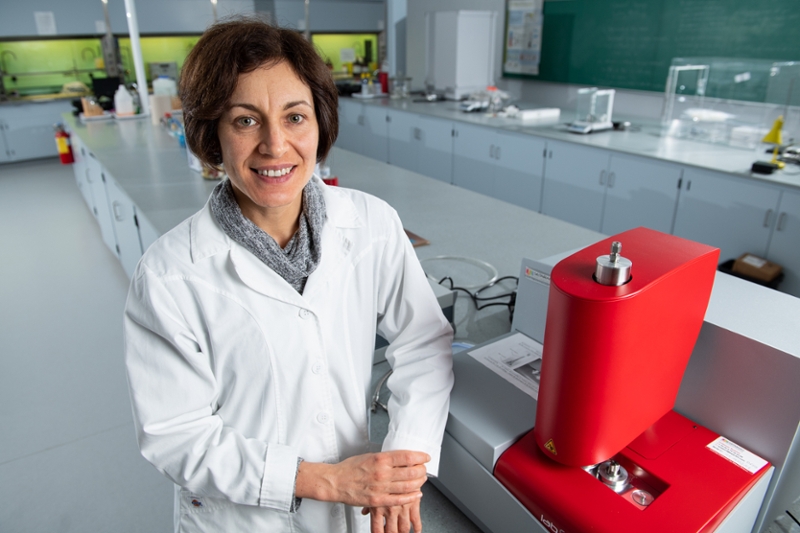COVID-19 research: Dr. Anna Ignaszak
Author: UNB Research
Posted on Jul 21, 2020

Around the world, researchers across all fields and disciplines are working to address the challenges, issues and implications of the 2019 novel coronavirus pandemic. Here at UNB, our own research community is part of that global movement.
We recently announced 13 new, funded COVID-19 research projects; here’s a little more about the expertise, the passion and the capacity behind one of them. Want to read the others? Find the full list of stories here.
Dr. Anna Ignaszak, Chemistry (Fredericton)
UNB's Dr. Anna Ignaszak's lab is working on a portable and miniaturized sensor that can detect the presence of viral proteins as soon as symptoms present, with a goal of increasing testing capacity with a rapid, lightweight and portable diagnostic method.
Who are you?
I came to UNB in 2015, after graduating with an MSc and PhD in my native Poland, working in the area of ionic conductors and sensors. I then completed a postdoctoral fellowship at the University of British Columbia and with the National Research Council in Vancouver, working on projects related to electrocatalysis and fuel cells, and collaborating with world-leading companies like Ballard Power Systems. Since 2012, when I obtained a junior faculty position at the Friedrich-Schiller University in Jena, I’ve continued developing new materials with improved functions for energy storage, flexible electronics, and electrochemical sensors. I’ve continued this work at UNB, where I am an Associate Professor in the department of Chemistry, and where I run a research laboratory dedicated to this area.
Research conducted in our laboratory centers on developing new materials for electrochemical sensors and energy storage. The first phase of research is to create new chemical molecules that have special functions – in our case the focus is on molecules that can transfer electrical charge. Once synthesized, we analyze them in order to better understand the atomic- and molecular-level interactions among these molecules. This helps us to predict how they will behave when integrated in electrochemical devices. Knowing their functions allows us to prototype and engineer new electrodes that can be used in various electrochemical systems, with emphasis on energy storage and conversion (like batteries and fuel cells) and new sensors for the detection of persistent diseases (like Lyme bacteria) or viral proteins (like the 2019 novel coronavirus). We are fascinated by how many of such biological species demonstrate electrochemical activity, and thus can be easily detected by electrodes developed in our laboratory.
What are you working on?
Currently, there are two primary diagnostic methods available to detect COVID-19. The first method reveals the presence of virus, and the second detects antibodies produced in bloodstream as a response to infection. In the first (called RT-PCR) method, results are generally available within a few hours. In the second method, detection of antibodies in blood shows whether person has had the disease.
However, antibodies are often not noticeable until a few days after symptoms begin. This means the method can deliver false results for early stage patients.
Along with Connor Flynn, one of my graduate students, I am working on a portable and miniaturized sensor that can detect the presence of viral proteins as soon as symptoms present. In this device, specific interactions between human and viral proteins generate changes in the resistance of the sensor platform. This effect is recognized as an electrical signal and recorded by the device. Our hope is that this platform will provide accurate results within minutes.
Ultimately, we hope to develop a rapid, lightweight, portable point-of-care diagnostic method that will be as cost-effective as current solutions. It will increase testing capacity, decrease waiting time in emergency departments and allow clinicians to promptly start treatment in high-risk populations and to formulate effective infection control measures.
Why did you decide to work on this research?
In my opinion, sharing scientific ideas in unprecedented situations like this pandemic is our responsibility. There is always an opportunity for scientific dialog where ideas can be further developed and improved, resulting in important outcomes that may change everybody’s life.
Our particular expertise in prototyping electrodes as a form of biomimicry may allow us to contribute new solutions to this global crisis, both in advancing the science generally, and in provided a usable testing device to health care practitioners.
This research is funded by the New Brunswick Innovation Foundation, the New Brunswick Health Research Foundation, and the Atlantic Canada Opportunities Agency as part of a special COVID-19 funding program.
Media: If you are interested in this story, and would like more information, please contact Jeremy Elder-Jubelin, Marketing and Communications Officer in the Office of Research Services.
More information:
Dr. Anna Ignaszak | Department of Chemistry, Fredericton
Research at UNB | Graduate Studies at UNB | Postdoctoral fellowships
Related Pages: COVID19 Research Stories